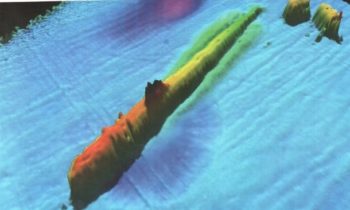 Russian scientists have again floated the possibility of raising a nuclear submarine that the Soviet Navy sank on purpose almost 40 years ago in an effort to salvage a long legacy of radioactive trash that the Soviet military for decades scuttled at sea.
Russian scientists have again floated the possibility of raising a nuclear submarine that the Soviet Navy sank on purpose almost 40 years ago in an effort to salvage a long legacy of radioactive trash that the Soviet military for decades scuttled at sea.
Russian scientists have again floated the possibility of raising a nuclear submarine that the Soviet Navy sank on purpose almost 40 years ago in an effort to salvage a long legacy of radioactive trash that the Soviet military for decades scuttled at sea.
St. Petersburg’s Krylov State Research Institute on Friday announced it was working on plans for a floating dock catamaran-type vessel capable of lifting military nuclear waste from the bottom of the sea as part of a government plan for Arctic development. According to the institute’s director, Sergei Malyshev, the K-27 nuclear submarine could be lifted by 2022.
The K-27, a November Class prototype submarine, was sunk by the navy in the shallows off the Novaya Zemlya Archipelago in 1981. Years before, in 1968, its reactor suffered a fatal leak, which damaged its fuel assemblies and killed nine.
The Soviet Navy attempted to repair the sub but failed, and instead technicians sealed its reactors and scuttled it near the archipelago dividing the Barents and Kara seas, which itself for decades served as a testing site for Soviet nuclear weapons.
The K-27 is one piece of a colossal drive to dump naval radioactive waste in the Artcic oceans that continued for decades.
A catalogue of the irradiated debris released to Norwegian radiation authorities by the Russian Navy in 2012 includes 17,000 containers of radioactive waste, 19 ships containing radioactive waste, 14 nuclear reactors, including five that still contain spent nuclear fuel, and 735 other pieces of radioactively contaminated heavy machinery.
In the early 1990s the navy finally agreed to stop dumping its old reactors and nuclear waste at sea. But in 2003, another decommissioned submarine, the K-159, sank in Arctic waters while it was under tow from the Gremikha naval installation near Arkhangelsk to the Nerpa shipyard on the Kola Peninsula for dismantlement.
That submarine’s loss, and the drowning of nine crewmembers who were aboard, in 238 meters of water renewed fears over Russia’s burgeoning undersea nuclear waste deposits and ignited discussions about bringing it and the K-27 to the surface.
“According to our information, the K-27 is the most dangerous of the dumped reactors,” Nils Bøhmer, Bellona’s general director and nuclear physicist said. “We welcome the lifting of this submarine provided it can be done in a safe way – the longer it’s underwater, the worse will be its condition and the harder it will be to lift.”
The K-27 is arguably more hazardous than its other radioactive cousins in the region. A scientific expedition to the vessel in 2012 concluded that its liquid metal cooled reactor was vulnerable to an uncontrolled chain reaction and a significant radioactive release.
But plans to raise the K-27 have been stutter-step and tend to recede as quickly as they are mentioned. These plans were again in the spotlight in 2015 when officials with Russian state nuclear corporation told a Bellona-hosted seminar that pulling the K-27 and the K-159 to the surface were a national priority. The plans have failed to gain momentum since.
Even casting the issue of retrieving radioactive waste as essential to Russia’s Arctic oil development – thus something that can be underwritten by foreign drillers – has failed to galvanize the financing or scientific expertise.
Still, Russia’s Emergency Services Ministry has repeatedly urged the government to devise a plan to lift the sub, and Norway has taken part in joint studies to determine whether it poses any dangers of contamination and if, indeed, it has maintained the structural integrity to be lifted from its shallow grave.
Scientists on the most recent such expedition, in 2013, determined that the submarine’s hull was still intact and hadn’t experienced any abnormal corrosion, but that several parts of its outer hull were missing.
A study a year earlier found slightly elevated levels of cesium 137 near the K-27’s sealed reactor. Encouragingly, levels of radionuclides around the submarine were lower in 2012 than they were when Norwegian authorities first visited the submarine twenty years earlier.
The vessel Malyshev at the Krylov Institute described as being in the planning phases sounded similar to other vessels numerous scientific institutes have proposed in the past, but which thus far have not been built.
Over the years, engineers have suggested a barge-like boat with the capability to raise several thousand tons from the seabed would be able to lift the K-27, and the K-159 as well. But the only ship that has come close to those specifications is the Italian-built Itarus.
In 2016, Rosatom suggested this vessel, which the Italians have built but still not delivered, would be able to lift scuttled submarines and sunken containers of radioactive waste.
(bellona)
